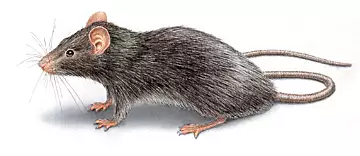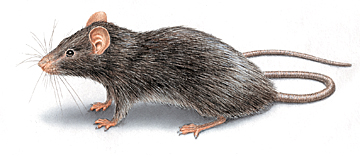- Contact
- 01211118453
- Send Email
- info@spider-eg.com
Roof Rats

Roof Rats
Facts, Identification, Control
Latin Name
Rattus rattus
Appearance
What Do They Look Like?

- Size: These rats can be over 40 cm long. They are smaller and sleeker than Norway rats.
- Color: Roof rats can be black or brown.
- Characteristics: These rodents have long tails, large ears and eyes, and pointed noses. They have smooth fur with hairless, scaly tails that are longer than their heads and bodies.
How Did I Get Roof Rats?
Roof rats can fit through holes as small as one-half inch in diameter. Because they prefer to be high in the air, these rodents may climb on power lines or tree branches to get on the roof.
Entry Points
These rats have no problem reaching almost any area of the house, so many homeowners struggle to keep these pests out. These rodents often enter homes from:
- Chewing entry holes
- Damaged vent covers
- Gaps in shingles
- Squeezing through cracks
How Serious Are Roof Rats?
Roof rats can cause extensive and costly damage from:
- Chewing on electrical wires
- Damaging furniture and storage boxes
- Ripping up insulation
Diseases
Roof rats spread diseases like salmonellosis through pantry foods contaminated with their droppings. These rats can also transmit rat bite fever through bacteria in their mouth. Trichinosis may be contracted through eating undercooked meat of animals that have fed on rats. Rats contaminating food or food preparation surfaces can transmit food poisoning.
Roof rats are the principle reservoir of plague throughout the world. Historically, infected fleas have transmitted serious plagues from rats to humans. Bubonic plague was a scourge in Europe several times throughout history. There are still outbreaks of plague in the United States and around the world today.
Hantavirus
Hantavirus pulmonary syndrome is transferred via inhalation of:
- Droppings
- Rodent urine
- Saliva
How Do They Transfer Diseases?
Common ways roof rats transmit diseases are from:
- Bites
- Contamination
- Droppings
- Fleas that feed on the rodents
- Physical contact
Signs of Infestation
Droppings
Droppings are a good indicator of roof rat activity. Their droppings are 12 to 13 mm with pointed ends, whereas Norway rat droppings are 18 to 20 mm and capsule shaped.
Grease Marks
Grease marks along surfaces can be signs of an infestation. Grease marks are produced as the rodent travels along an edge, and the oils in their fur are deposited.
Visual Sightings
Sightings of live or dead rodents indicate rodent activity. If roof rats are seen exposed, it often indicates their hiding spaces are all filled by other rats or that they have been disturbed, such as by construction. You can find indoor nests constructed in insulation area including attics.
How Do I Get Rid of Roof Rats?
What You Can Do
Here’s how homeowners can help prevent roof rat infestations:
- Block Entryways: To prevent a roof rats from nesting in your home, make sure that all windows and vents are screened.
- Trim Trees: These rodents can get to the roof from the branches of trees. Trim all tree branches to further prevent entry.

